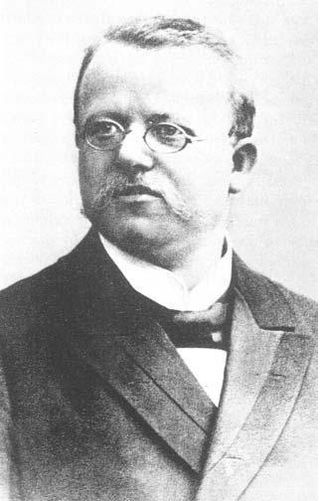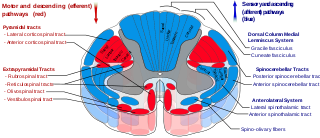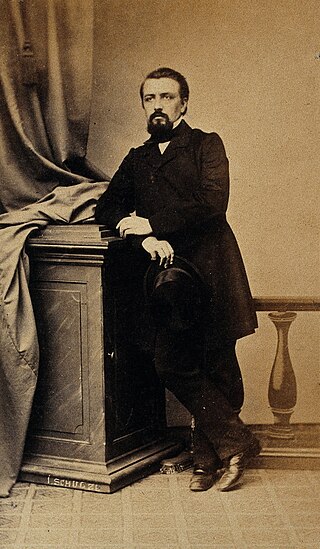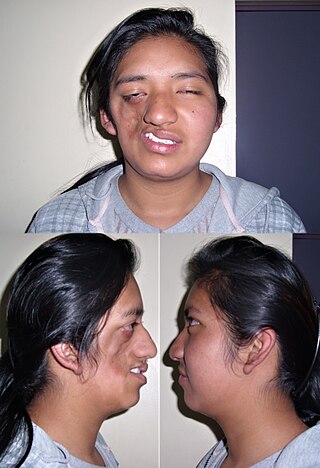
Neurology is the branch of medicine dealing with the diagnosis and treatment of all categories of conditions and disease involving the nervous system, which comprises the brain, the spinal cord and the peripheral nerves. Neurological practice relies heavily on the field of neuroscience, the scientific study of the nervous system.

Tabes dorsalis is a late consequence of neurosyphilis, characterized by the slow degeneration of the neural tracts primarily in the dorsal root ganglia of the spinal cord. These patients have lancinating nerve root pain which is aggravated by coughing, and features of sensory ataxia with ocular involvement.

Henoch–Schönlein purpura (HSP), also known as IgA vasculitis, is a disease of the skin, mucous membranes, and sometimes other organs that most commonly affects children. In the skin, the disease causes palpable purpura, often with joint pain and abdominal pain. With kidney involvement, there may be a loss of small amounts of blood and protein in the urine, but this usually goes unnoticed; in a small proportion of cases, the kidney involvement proceeds to chronic kidney disease. HSP is often preceded by an infection, such as a throat infection.

Hermann Oppenheim was one of the leading neurologists in Germany.

The Charité – Universitätsmedizin Berlin is Europe's largest university hospital, affiliated with Humboldt University and the Free University of Berlin.

Romberg's test, Romberg's sign, or the Romberg maneuver is a test used in an exam of neurological function for balance. The exam is based on the premise that a person requires at least two of the three following senses to maintain balance while standing: proprioception ; vestibular function ; and vision.

Eduard Heinrich Henoch was a German physician. He taught at the Berlin University (1868–1894). Henoch was of Jewish descent, and was the nephew of Moritz Heinrich Romberg.

Nikolaus Friedreich was a German pathologist and neurologist, and a third generation physician in the Friedreich family. His father was psychiatrist Johann Baptist Friedreich (1796–1862), and his grandfather was pathologist Nicolaus Anton Friedreich (1761–1836), who is remembered for his early description of idiopathic facial paralysis, which would later be known as Bell's palsy.

Karl Friedrich Otto Westphal was a German psychiatrist from Berlin. He was the son of Otto Carl Friedrich Westphal (1800–1879) and Karoline Friederike Heine and the father of Alexander Karl Otto Westphal (1863–1941). He was married to Klara, daughter of the banker Alexander Mendelssohn. Westphal died in Kreuzlingen in 1890.

Parry–Romberg syndrome (PRS) is a rare disease presenting in early childhood characterized by progressive shrinkage and degeneration of the tissues beneath the skin, usually on only one side of the face but occasionally extending to other parts of the body. An autoimmune mechanism is suspected, and the syndrome may be a variant of localized scleroderma, but the precise cause and pathogenesis of this acquired disorder remains unknown. It has been reported in the literature as a possible consequence of sympathectomy. The syndrome has a higher prevalence in females and typically appears between 5 and 15 years of age. There has been only one case report of the syndrome appearing in older adults: a 43-year-old woman with symptoms appearing at the age of 33.

Paul Julius Möbius was a German neurologist born in Leipzig. His grandfather was German mathematician and theoretical astronomer, August Ferdinand Möbius (1790–1868).

Otto Ludwig Binswanger was a Swiss psychiatrist and neurologist who came from a famous family of physicians; his father was founder of the Kreuzlingen Sanatorium, and he was uncle to Ludwig Binswanger (1881–1966) who was a major figure in the existential psychology movement. He was brother-in-law to physiotherapist Heinrich Averbeck (1844–1889). Other notable family members include his son-in-law Hans-Constantin Paulssen (1892-1984), who was the first president of the BDA.

Wilhelm Griesinger was a German neurologist and psychiatrist born in Stuttgart.

Sir Edward Henry Sieveking was an English physician.

Richard Cassirer was a German neurologist born into a Jewish family in Breslau.

Albert Eulenburg was a German neurologist born in Berlin.

Friedrich Schultze was a German neurologist and native of Rathenow, Brandenburg. He is known for being the founder of child neurology.

Anton Ludwig Ernst Horn was a German physician who was a native of Braunschweig.
The Howship–Romberg sign is inner thigh pain on internal rotation of the hip. It can be caused by an obturator hernia. It is named for John Howship and Moritz Heinrich Romberg.

Ernst Siemerling was a German neurologist and psychiatrist born in Müssow near Greifswald.



















